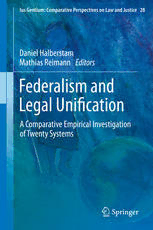
Federalism and Legal Unification: A Comparative Empirical Investigation of Twenty Systems PDF
Preview Federalism and Legal Unification: A Comparative Empirical Investigation of Twenty Systems
Ius Gentium: Comparative Perspectives on Law and Justice 28 Daniel Halberstam Mathias Reimann Editors Federalism and Legal Unifi cation A Comparative Empirical Investigation of Twenty Systems Federalism and Legal Unification IUS GENTIUM COMPARATIVEPERSPECTIVESONLAWANDJUSTICE VOLUME28 SeriesEditors MortimerSellers UniversityofBaltimore JamesMaxeiner UniversityofBaltimore BoardofEditors MyroslavaAntonovych,Kyiv-MohylaAcademy NadiadeAraújo,PontificalCatholicUniversityofRiodeJaneiro JasnaBakšic-Muftic,UniversityofSarajevo DavidL.CareyMiller,UniversityofAberdeen LoussiaP.MusseFélix,UniversityofBrasilia EmanuelGross,UniversityofHaifa JamesE.Hickey,Jr.,HofstraUniversity JanKlabbers,UniversityofHelsinki CláudiaLimaMarques,FederalUniversityofRioGrandedoSul AnicetoMasferrer,UniversityofValencia EricMillard,WestParisUniversity GabriëlMoens,CurtinUniversity RaulC.Pangalangan,UniversityofthePhilippines RicardoLeitePinto,LusíadaUniversityofLisbon MizanurRahman,UniversityofDhaka KeitaSato,ChuoUniversity PoonamSaxena,UniversityofDelhi GerrySimpson,LondonSchoolofEconomics EduardSomers,UniversityofGhent XinqiangSun,ShandongUniversity TadeuszTomaszewski,WarsawUniversity JaapdeZwaan,ErasmusUniversityRotterdam Forfurthervolumes: http://www.springer.com/series/7888 Daniel Halberstam • Mathias Reimann Editors Federalism and Legal Unification A Comparative Empirical Investigation of Twenty Systems 123 Editors DanielHalberstam MathiasReimann EricSteinCollegiateProfessorofLaw HesselE.YntemaProfessorofLaw UniversityofMichiganLawSchool UniversityofMichiganLawSchool AnnArbor,MI,USA AnnArbor,MI,USA ISBN978-94-007-7397-4 ISBN978-94-007-7398-1(eBook) DOI10.1007/978-94-007-7398-1 SpringerDordrechtHeidelbergNewYorkLondon LibraryofCongressControlNumber:2013952745 ©SpringerScience+BusinessMediaDordrecht2014 Thisworkissubjecttocopyright.AllrightsarereservedbythePublisher,whetherthewholeorpartof thematerialisconcerned,specificallytherightsoftranslation,reprinting,reuseofillustrations,recitation, broadcasting,reproductiononmicrofilmsorinanyotherphysicalway,andtransmissionorinformation storageandretrieval,electronicadaptation,computersoftware,orbysimilarordissimilarmethodology nowknownorhereafterdeveloped.Exemptedfromthislegalreservationarebriefexcerptsinconnection with reviews or scholarly analysis or material supplied specifically for the purpose of being entered and executed on a computer system, for exclusive use by the purchaser of the work. Duplication of this publication or parts thereof is permitted only under the provisions of the Copyright Law of the Publisher’slocation,initscurrentversion,andpermissionforusemustalwaysbeobtainedfromSpringer. PermissionsforusemaybeobtainedthroughRightsLinkattheCopyrightClearanceCenter.Violations areliabletoprosecutionundertherespectiveCopyrightLaw. Theuseofgeneraldescriptivenames,registerednames,trademarks,servicemarks,etc.inthispublication doesnotimply,evenintheabsenceofaspecificstatement,thatsuchnamesareexemptfromtherelevant protectivelawsandregulationsandthereforefreeforgeneraluse. While the advice and information in this book are believed to be true and accurate at the date of publication,neithertheauthorsnortheeditorsnorthepublishercanacceptanylegalresponsibilityfor anyerrorsoromissionsthatmaybemade.Thepublishermakesnowarranty,expressorimplied,with respecttothematerialcontainedherein. Printedonacid-freepaper SpringerispartofSpringerScience+BusinessMedia(www.springer.com) Preface If federalism means unity in diversity and diversity in unity, the uniformity of lawsoughttobecentraltothediscussionaboutwhetherfederalismdeliversonits promise.Thisgroundbreakingbookbeginsthatconversationinearnest. The International Academy of Comparative Law was innovative when in Novemberof 2008it convenedat the Institute for LegalResearch of the National Autonomous University of Mexico in Mexico City its first thematic congress entitled “The Impact of Uniform Law in National Law: Possibilities and Limits”. Forthefirsttime,theAcademyhostedacongressonadiscretetheme,asopposedto the much largermulti-themedWorld Congressesof Comparativelaw traditionally heldevery4years. Among the topics selected for this thematic congresswas uniformityof law in federalsystems. The conferencetherebysparkedthe inquirythat led to this book. Professors Daniel Halberstam and Mathias Reimann have conducted a detailed comparativestudy yielding remarkablydeep and precise understandingsbased on comparativeempiricalresearchacrossarangeoflegalsystems,includingArgentina, Australia, Belgium, Brazil, Canada, Germany, India, Italy, Malaysia, Mexico, the Netherlands, Russia, Spain, South Africa, Switzerland, the United Kingdom, the United States, Venezuela, as well as the supranationalentity that is the European Union.Theselegalsystemsspanthecivilandcommonlawworldsandarediverse intermsofage,size,structure,andpopulation. Professors Halberstam and Reimann chose these systems according to their workingdefinitionof a federalsystem as “a compoundpolity with multiplelevels of government each with constitutionally grounded claims to some degree of organizationalautonomyanddirectlegalauthorityoveritscitizens.”Theyengaged national experts to prepare a national report for each system and to provide the informationnecessaryfortheirowncross-cuttingcomparativeanalysis. The resulting comparative investigation is divided into three distinct parts: the differentmodesof legalunification,the currentlevelof unificationacross various systemsandareasoflaw,andananalysisandexplanationoftheresults. The first part traces how unification or harmonizationof law may stem from a variety of sources, including the exercise of coercive central governmentpowers, v vi Preface variousformsofvoluntarycoordination(which,inturn,involvecomponentgovern- mentinitiativesandnongovernmentalactorswhodraftrestatements,principlesor modellaws),andnationalsystemsofprofessionaleducation.ProfessorsHalberstam andReimann show the varyingdegreesto which these differentfactorscontribute tolegalunification.Theyconcludethattheimpetusforunificationstemsprincipally from central sources of power, especially central legislation, with other factors playing a less instrumental role. This conclusion alone will be both useful and sobering as some federal systems, such as the supranational European Union, contemplatedifferentwaysofincreasingtheuniformityoflawwithinitssystem. In the second part, the authors examine the level of unification that has been achievedacrossavarietyofdimensions. After considering uniformity by area of law and by federation, Professors HalberstamandReimannconsiderseveralhypothesesaboutwhatdrivesunification. Theyevaluateandcautiouslyconfirmtheimportanceof“legislativecentralization,” consider and end up rejecting the independent significance of “structural central- ization,” and, to the surprise of those who thought that legal traditions no longer matter, cautiously confirm a “legal traditions” hypothesis. This latter finding will require comparative law scholars to rethink the currently fashionable conclusion thatweliveinaworldthathasescapedthesignificanceofthecivilv.commonlaw divide. This ambitious study provides by far the most comprehensive and systematic examination of legal unification in federal systems to date. No other study has attemptedtoconsidermorethanoneortwoareasofthelawandmorethanasmall handfuloflegalsystems. Finally,themethodologyoftheresearchuponwhichthepresentvolumerestsis highlyoriginal.Itcomplementsthelargelytheoreticalliteraturewithaninnovative effortat data collection and analysis. The work thus expandsour appreciationnot onlyoftheparticularsubjectathand–legalunificationinfederalsystems–butof theprofoundutilityandcontinuedpromiseofthecomparativelawmethod. NewYorkandMexicoCity GeorgeA.Bermann JorgeA.SánchezCordero Acknowledgements This book is the result of a collaborativeeffort.We thank the NationalReporters, whoseindividualreportsmaybefoundinPartIIofthisbook,fortheircontributions. Thisprojectwould nothave beenpossible withoutthem. We also thank the many additionalexperts,whoaretoonumeroustomentionhere,fortheirtimeandeffort tofilloutscorecardsasexplainedinAppendix2. We give special thanks to Jennifer Miller, a Ph.D. student in the University of Michigan Department of Political Science, and to Joanna Lampe, a J.D. student at the University of Michigan Law School, for outstanding research assistance, to Cynthia Bever and Pamela Tanner, our faculty assistants at the University of MichiganLawSchool,forextraordinaryhelpinmanagingthisproject,andtoSarah BullardandMarthaKreutzerforhelpineditingthenationalreports. WearegratefultoourcolleaguesJennaBednar,StevenCroley,JohndiNardo,Jim Hines,KenKollman,RickLempert,J.J.Prescott,AdamPritchard,andMarkWest forvaluablecommentsanddiscussions.WealsothanktheUniversityofMichigan LawSchoolandtheCookResearchFundforsupport. Three nationalreportsare based on earlier publications.Jeffrey Kahn, Nikolay Balayan,andAlexeiTrochev,“TheUnificationofLawintheRussianFederation,” 25 Post-Soviet Affairs 310–346 (2009); Aline Grenon, “Unification of Laws in Federal Systems: The Canadian Model” in: Nathalie Vézina (ed.), Uniform Law: LimitsandPossibilities33–61(Quebec:Carswell,2009);andLouisF.DelDucaand PatrickDelDuca,“AnItalianFederalism?—theState,itsInstitutions,andNational Culture as Rule of Law Guarantor”, 54 American Journal of Comparative Law 799–842(2006).Wethankthoseauthorsandpublishersfortheirpermissiontouse thosematerialshere. Finally,wethanktheInternationalAcademyofComparativeLaw,underwhose auspicesthefirsteditionofthisstudywaspublishedlastyear. AnnArbor DanielHalberstam June1,2013 MathiasReimann vii Contents PartI ComparativeAnalysis 1 FederalismandLegalUnification:ComparingMethods, Results,andExplanationsAcross20Systems........................... 3 DanielHalberstamandMathiasReimann PartII NationalReports 2 TheArgentineFederalLegislativeSystem............................... 71 AlfredoM.Vítolo 3 TheAustralianFederation:AStoryoftheCentralizationofPower.. 87 CherylSaundersandMichelleFoster 4 FederalismandLegalUnificationinAustria............................ 103 AnnaM.GamperandBernhardA.Koch 5 Belgium:ABrokenMarriage?............................................ 121 Alain-LaurentVerbeke 6 FederalismandLegalUnificationinBrazil.............................. 153 JacobDolingerandLuísRobertoBarroso 7 UnificationofLawsinFederalSystems:TheCanadianModel ....... 169 AlineGrenon 8 TheEuropeanUnion:AFederationinAllbutName .................. 191 JanWouters,HanneCuyckens,andThomasRamopoulos 9 UnificationofLawsintheFederalSystemofGermany................ 237 JürgenAdamandChristophMöllers 10 India:FromPoliticalFederalismandFiscalCentralization toGreaterSubnationalAutonomy........................................ 255 SunitaParikh ix
